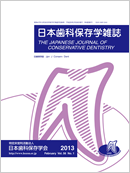Volume 52, Issue 6
Displaying 1-12 of 12 articles from this issue
- |<
- <
- 1
- >
- >|
Original Articles
-
Article type: Original Articles
2009 Volume 52 Issue 6 Pages 441-445
Published: December 31, 2009
Released on J-STAGE: March 30, 2018
Download PDF (602K) -
Article type: Original Articles
2009 Volume 52 Issue 6 Pages 446-452
Published: December 31, 2009
Released on J-STAGE: March 30, 2018
Download PDF (811K) -
Article type: Original Articles
2009 Volume 52 Issue 6 Pages 453-459
Published: December 31, 2009
Released on J-STAGE: March 30, 2018
Download PDF (755K) -
Article type: Original Articles
2009 Volume 52 Issue 6 Pages 460-468
Published: December 31, 2009
Released on J-STAGE: March 30, 2018
Download PDF (971K) -
Article type: Original Articles
2009 Volume 52 Issue 6 Pages 469-482
Published: December 31, 2009
Released on J-STAGE: March 30, 2018
Download PDF (9114K) -
Article type: Original Articles
2009 Volume 52 Issue 6 Pages 483-492
Published: December 31, 2009
Released on J-STAGE: March 30, 2018
Download PDF (5302K) -
Article type: Original Articles
2009 Volume 52 Issue 6 Pages 493-504
Published: December 31, 2009
Released on J-STAGE: March 30, 2018
Download PDF (53448K) -
Article type: Original Articles
2009 Volume 52 Issue 6 Pages 505-512
Published: December 31, 2009
Released on J-STAGE: March 30, 2018
Download PDF (1281K) -
Article type: Original Articles
2009 Volume 52 Issue 6 Pages 513-518
Published: December 31, 2009
Released on J-STAGE: March 30, 2018
Download PDF (678K) -
Article type: Original Articles
2009 Volume 52 Issue 6 Pages 519-526
Published: December 31, 2009
Released on J-STAGE: March 30, 2018
Download PDF (1251K) -
Article type: Original Articles
2009 Volume 52 Issue 6 Pages 527-533
Published: December 31, 2009
Released on J-STAGE: March 30, 2018
Download PDF (832K) -
Article type: Original Articles
2009 Volume 52 Issue 6 Pages 534-542
Published: December 31, 2009
Released on J-STAGE: March 30, 2018
Download PDF (3115K)
- |<
- <
- 1
- >
- >|
